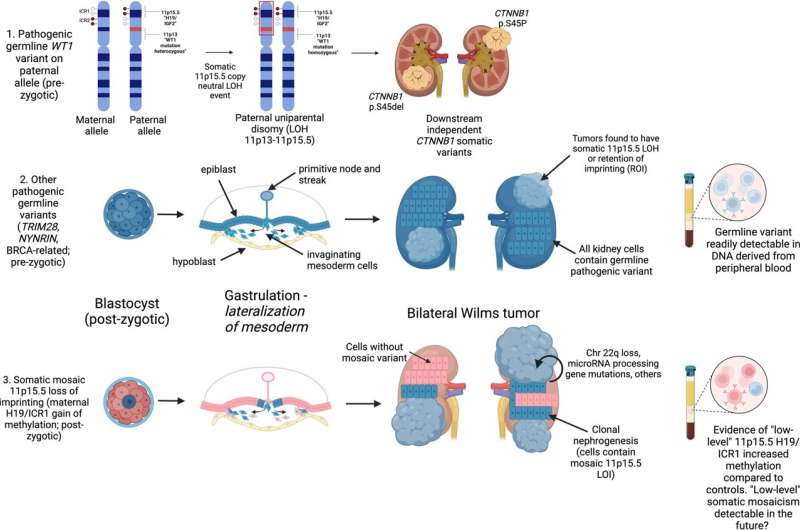This article has been reviewed according to Science X's editorial process and policies. Editors have highlighted the following attributes while ensuring the content's credibility:
fact-checked
peer-reviewed publication
trusted source
proofread
Unraveling predisposition in bilateral Wilms tumor

Children with bilateral Wilms tumor have a tumor in each of their kidneys—a condition that strongly suggests an underlying genetic or epigenetic predisposition driving the disease. Scientists at St. Jude Children's Research Hospital gathered a large cohort of bilateral Wilms tumor samples and conducted analyses to assess which factors contribute to predisposition comprehensively.
The work has implications for counseling patient families, guiding treatment decisions and informing the design of future clinical trials. The study was published in Nature Communications.
Having tumors in both organs makes treating bilateral Wilms tumor more complicated. When Wilms tumor occurs in just one kidney, surgeons can remove the entire organ. But with bilateral Wilms tumor, removing both kidneys would eliminate renal function. Instead, patients first need chemotherapy to shrink the tumors as much as possible, followed by organ-sparing surgery to remove the tumors without removing the whole kidney.
"We see a lot of patients with bilateral Wilms tumor here at St. Jude, offering these organ-sparing surgeries so that patients do not become dependent on dialysis and require kidney transplants," said co-corresponding author Andrew Murphy, MD, St. Jude Department of Surgery. "This means we were also uniquely privileged to have access to patient tissue samples to enable us to do this research, to establish the relative frequencies of different modes of predisposition."
The researchers gathered a cohort of bilateral Wilms tumor samples from patients treated at St. Jude as well as on the Children's Oncology Group study AREN18B5-Q. This cohort, the largest reported for bilateral Wilms tumor, allowed the researchers to conduct whole exome, whole genome, RNA-sequencing and DNA methylation analyses to unravel the factors involved in predisposition.
Genetic and epigenetic factors drive Wilms tumor predisposition
Through their analyses, the researchers determined the predominant genomic events predisposing patients to bilateral Wilms tumor. These include pre-zygotic germline (inherited) variants detectable in blood samples, such as WT1, NYNRIN, TRIM28 and BRCA-related genes.
The researchers also identified an epigenetic mechanism causing predisposition. They found post-zygotic (forming in the early embryo) hypermethylation at 11p15.5 H19/ICR1 predisposes patients to bilateral Wilms tumor.
DNA methylation is a fundamental biologic process in which methyl groups are added to the cytosine residues of DNA. The process guides the instructions for how gene expression is regulated. In this case, abnormal hypermethylation on the copy of chromosome 11p15.5 inherited from the mother leads to increases in gene expression.
In bilateral Wilms tumor, this phenomenon (also called loss of imprinting at 11p15.5) leads to the increased expression of IGF2—one of the major genes previously implicated in predisposition.
The researchers also found evidence of hypermethylation at 11p15.5 in the blood of patients with bilateral Wilms tumor, not just the tumor or in the non-diseased kidney. This hypermethylation signature was found at higher levels than in unilateral Wilms tumor or healthy individuals.
"Realizing that a pair of bilateral tumors from the same patient shared almost no somatic mutations, we suspected there were several ways genomes predisposed patients to develop bilateral Wilms' tumors, but it is essential to drive the research forward to holistically determine their frequency and interplay across a large cohort," said co-corresponding author Xiang Chen, Ph.D., St. Jude Department of Computational Biology.
"We needed to study germline and post-zygotic factors by integrating analyses, and we have now thoroughly characterized the landscape of predisposing events."
A 'mosaic' of predisposing factors
Wilms tumor is the most common kidney cancer of childhood, but just 5–7% of all Wilms tumor patients are diagnosed with bilateral Wilms tumor. Patients with bilateral Wilms tumor are diagnosed younger and often have precursor lesions called nephrogenic rests (clusters of undifferentiated embryonic kidney cells).
For decades, researchers suspected that bilateral Wilms tumor likely occurred due to a convergence of pre- and post-zygotic genomic effects: two (or more) genetic hits that together form a variety of effects driving predisposition. The St. Jude team's work provides support for the concept of mosaicism, where these predisposing genetic or epigenetic abnormalities are found in some, but not all, cells in the body.
Based on this new understanding, researchers are already exploring ways to incorporate these findings in the design of the next co-operative group clinical trial for Wilms tumor.
"We hope that once these data are established, these findings will become prospective biomarkers for treatment response or prognosis and can be included in the next generation of clinical trials," said Murphy.
More information: Murphy, A.J. et al, Genetic and epigenetic features of bilateral Wilms tumor predisposition in patients from the Children's Oncology Group AREN18B5-Q. Nature Communications (2023). DOI: 10.1038/s41467-023-43730-0


















